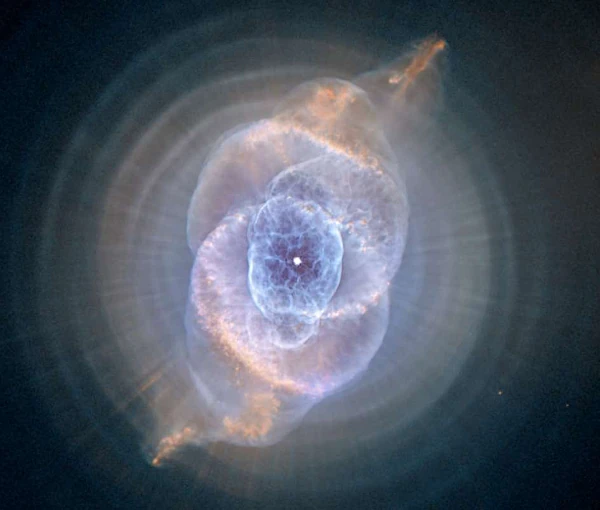
Image description: In a Planetary Nebula, the ultraviolet radiation from the central star excites the atoms of the ejected matter, giving each element a characteristic different color. Planetary nebulae do not live long; they disperse in less than 50,000 years.
Planetary Nebulae appear as simple planet-shaped spheres when viewed with a small telescope. However, the Hubble Space Telescope can show us the details of these magnificent celestial objects today. Planetary nebulae have various spherical shapes; they are balls of matter and fluorescent gas expelled by a dying central star. The intense heat winds and radiations from the central dwarf star create the characteristic shape of the nebulae. The dying central star shines like thousands of Suns, expelling its outer gaseous layers and exposing its burning core, whose strong ultraviolet radiation illuminates the ejected gas. Nebulae showing the death of a star are common, so astronomers have closely studied the different stages of this well-understood scenario. Planetary nebulae are the most beautiful cosmic objects that can be admired with a large telescope.
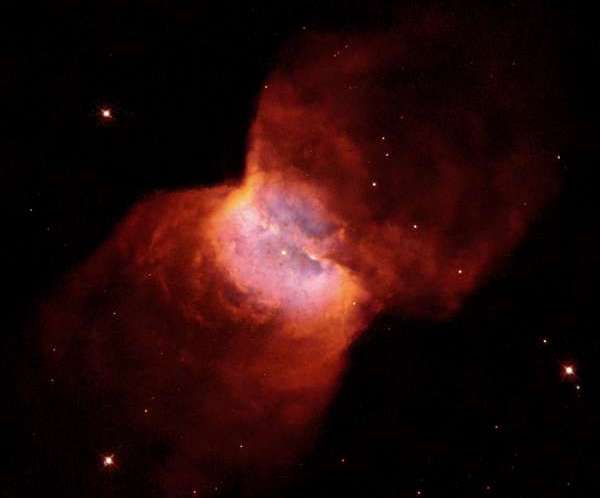
Image description: The Butterfly Nebula as seen by the Hubble Space Telescope. The luminous clusters of the night sky are often named after flowers or insects. Credit: NASA.
The Butterfly Nebula is located about 2,100 light-years from Earth in the direction of the constellation Monoceros. The image shows the last moments of a spectacular binary star system at the center of the nebula. These two stars are so close that they orbit each other in just 16 days. Even with Hubble, the pair of stars cannot be seen as two separate components because they are so close together. One of the stars is believed to be the remains of a star absorbed by the other. Astronomers think that one of the stars, as it evolved, became a red giant and literally absorbed its companion. The stars spiraled together, and most of the outer layers of the red giant were ejected into a dense bipolar disk that now surrounds the central star. The nebula is also rich in dust clouds, some of which form long dark streaks pointing away from the central star.
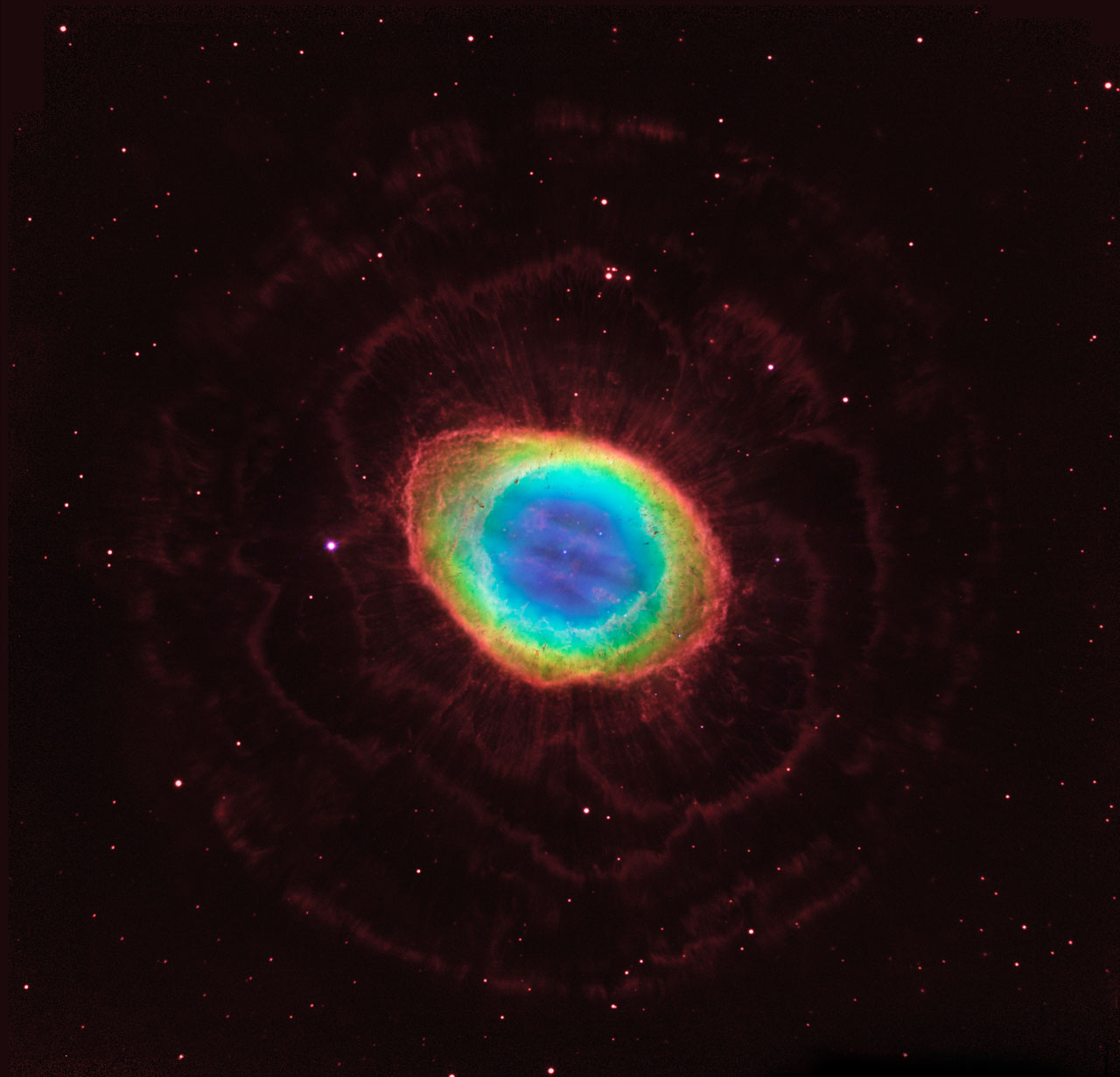
Image description: The Planetary Nebula of the Ring or Lyre or M57 or NGC 6720 taken by the Hubble Telescope. The visible light image captured by the Hubble Space Telescope is combined with infrared data from the Large Binocular Telescope on the ground in Arizona. Credit: NASA, ESA, CR O'Dell Robert (Vanderbilt University), GJ Ferland (University of Kentucky), WJ Henney and M. Peimbert (National Autonomous University of Mexico). Credit for binocular telescope data: David Thompson (University of Arizona).
The Ring or Lyre Nebula, discovered in 1779 by Antoine Darquier de Pellepoix, is one of the most famous objects in the Messier catalog. This annular nebula resembles the Helix Nebula. The actual diameter of the ring is 1.3 light-years, with an apparent diameter of about 2 arcminutes. The visible ring is composed of ionized oxygen and nitrogen. The outer edge of the ring is composed of hydrogen. The dark part inside the ring is made of helium and emits in the ultraviolet. M57 is often called the Ring Nebula, Lyre Nebula, or simply the Lyre, named after its host constellation. A planetary nebula is a thin disk with irregular shapes and sumptuous colors. They were named this way because, when viewed in a small instrument in the early days of observation, they appeared as pale planets. They appear as nebulae of small angular dimensions, often circular in shape, well-symmetrical and well-defined, unlike diffuse nebulae that seem to dilute in space and have an irregular shape. Many planetary nebulae have a ring shape, like the Lyre ring. They show a higher density of matter at the periphery than in the interior. A star is always at the center.
At the end of their life, when they have exhausted their hydrogen, the outer layers of stars expand and cool while the core collapses and heats up to reach the helium fusion temperature. Some stars go so far as to eject their outer layers, creating an expanding cocoon. The exposed core is a type W or O star that emits a lot of ultraviolet light and excites the nebula.
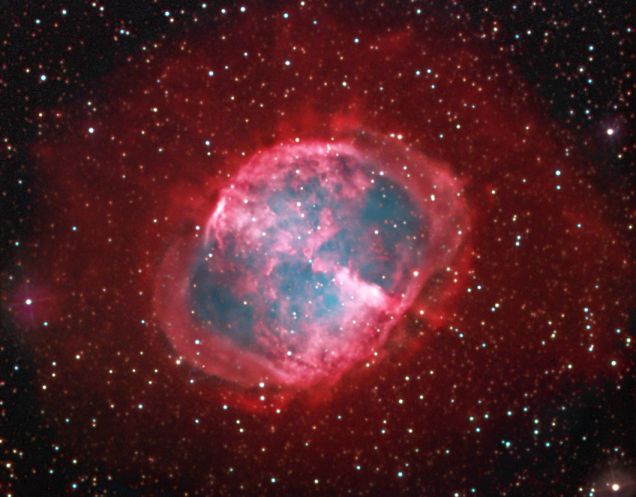
Image description: The bipolar Planetary Nebula Dumbbell (M27) is an excellent example of a gas emission nebula ejected by stars lacking nuclear fuel at the end of their life. This causes the expulsion of the star's outer layers into space. The residual glow is generated by the excited atoms of the star in its terminal phase. These atoms still generate an intense, invisible ultraviolet glow.
The bright Dumbbell Nebula reveals the central star of Dumbbell and a network of foreground and background stars in the rosy constellation of the Fox (Vulpecula in Latin). The composite image totals 8 hours of exposure through a filter designed to record only the light from hydrogen atoms, tracing the structure of the faint outer halo of the nebula that extends over light-years. The Dumbbell Nebula is similar to what will happen to our Sun when it runs out of nuclear fuel.
The central star (origin of the nebula) has an apparent magnitude of 13.5, making it difficult to observe for an amateur astronomer. It is a very hot blue-colored white dwarf (85,000K). It is accompanied by another even fainter star (magnitude 17).
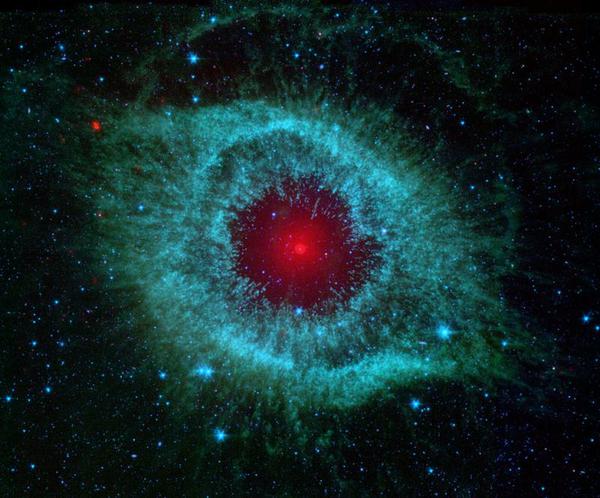
Image description: The Helix Nebula (NGC 7293) as seen by the Spitzer Space Telescope. The outer gaseous layers are represented in blue and green light. The tiny white dot at the center of the photograph is the white dwarf star immersed in surprisingly bright infrared light. The red color in the middle of the eye represents the last layers of gas blown away during the star's death. The bright red circle in the center is the glow of a dust disk surrounding the white dwarf star. All the inner planets of the system were carbonized or vaporized as the volume of the dying star increased.
The Helix Nebula is a cosmic star often photographed by amateur astronomers for its vivid colors and resemblance to a giant eye. The nebula, discovered in the 18th century, is located about 650 light-years away in the constellation Aquarius and belongs to a class of objects called planetary nebulae. Planetary nebulae are the remnants of stars that once resembled our Sun. When these stars die, they expel their outer gaseous layers into space. These layers are heated by the hot core of the dead star, a white dwarf, and shine in infrared and visible wavelengths. Our Sun will undergo the same evolution when it dies in about five billion years.
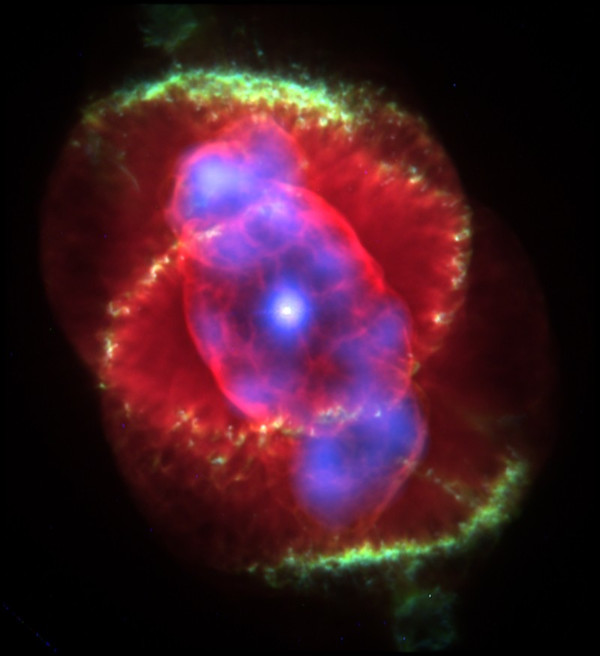
Image description: The Cat's Eye Nebula or NGC 6543 as seen by the Hubble Space Telescope. The central star is dying, projecting concentric clouds of dust and gas around it. Astronomers see the destiny of our Sun in this star when it enters its final phase in 5 billion years.
The Cat's Eye Nebula (NGC 6543), with a diameter of 20 arcseconds, is located at the north pole of the ecliptic, 3,000 light-years from Earth. This very bright planetary nebula is located in the constellation Draco. This nebula has a very extended halo of matter ejected during its red giant phase. The halo measures 386 arcseconds (5.8 arcminutes). According to one interpretation, a binary system is the origin of the nebula. The dynamic effects of two stars orbiting each other more easily explain the structure of this nebula, which appears much more complex than most other known planetary nebulae. According to this model, the stellar wind of the central star created the elongated envelope made of dense and luminous gas. This structure is included within two lobes of gas ejected earlier by this star. These lobes are marked by a denser ring of gas, probably ejected in the orbital plane of the central star's companion.
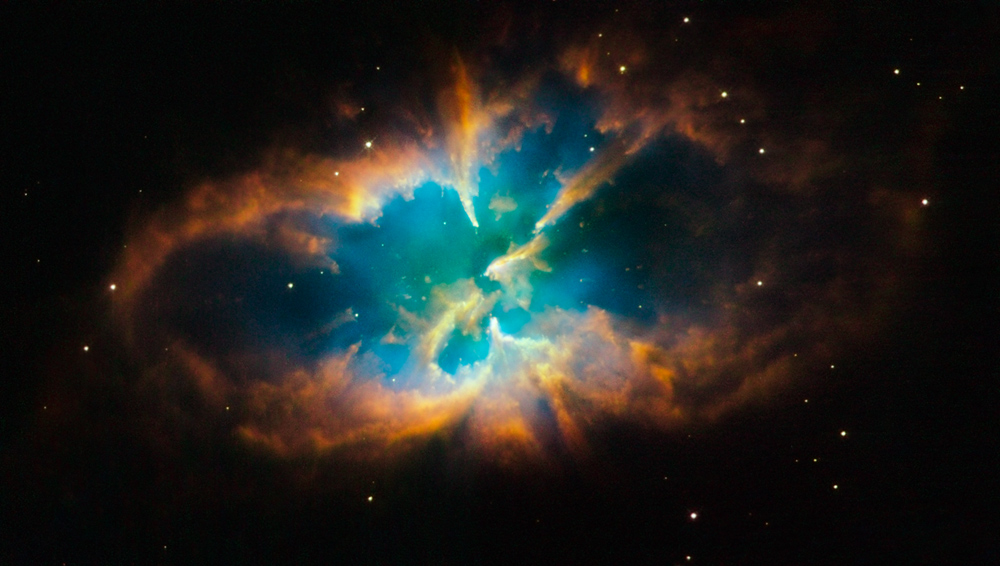
Image description: Source: Hubble press release & Gilbert Javaux - PGJ Astronomie. Illustration: NASA, ESA, and the Hubble Heritage Team (STScI/AURA).
The Planetary Nebula NGC 2818 is nestled within the open star cluster NGC 2818A and has a visual magnitude of 8.2, making it invisible to the naked eye. The cluster and nebula are located more than 10,000 light-years away in the southern constellation Pyxis. The observed colors come from different elements, more or less ionized, each emitting in a specific wavelength. The colors of this image represent a range of emissions from the nebula's clouds. Red represents nitrogen, green represents hydrogen, and blue represents oxygen. The name "planetary nebula" comes from the first observations of these objects, which sometimes have a circular appearance, like a planet. In reality, these are stars that have reached the end of their life and violently expel a large part of the matter that composes them in the form of gas. The planetary nebula NGC 2818 is detached from the surrounding stars. This image of Hubble was taken in November 2008 with the WFPC2 (Wide Field Planetary Camera 2) instrument.
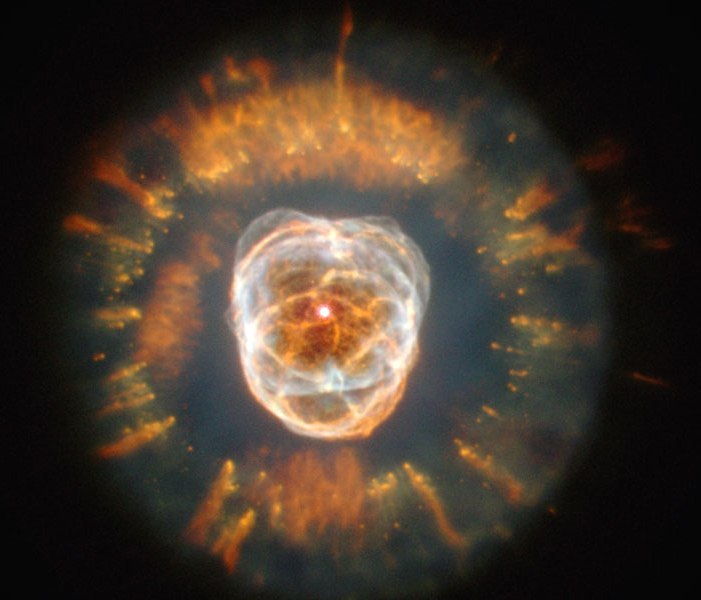
Image description: Image taken by the Hubble Space Telescope in January 2000. Its concentric rings justify its name as the Eskimo Nebula. Its modest apparent magnitude (9.90) does not allow it to be seen with the naked eye, but it can be observed with small instruments. Credit: NASA.
The Eskimo Planetary Nebula (NGC 2392) was discovered in 1787 by astronomer William Herschel in the constellation Gemini. NGC 2392 resembles a head surrounded by a parka. This nebula consists of two disks: the inner disk is quite bright, and the outer disk is in the shape of an irregular ring. NGC 2392 is about 4,000 light-years away. Just 10,000 years ago, the visible gas in the image constituted the outer layers of a solar-type star. The central star is clearly visible in this image. The inner filaments visible in white were ejected by violent particle winds from this central star. The outer disk contains orange filaments about one light-year long.
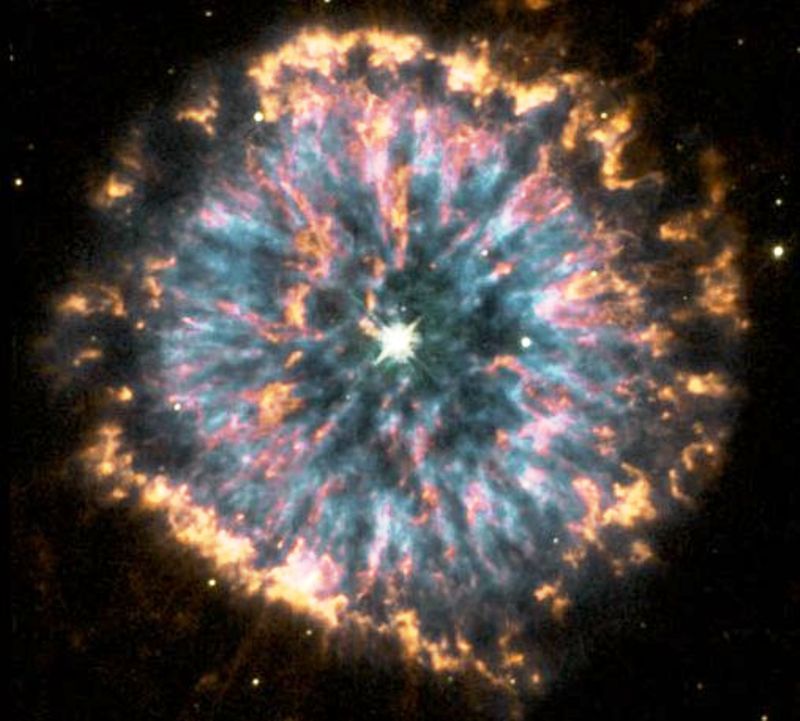
Image description: The gas cloud of the planetary nebula NGC 6751 resembles a celestial eye. The dying star is at the center, and its winds eject dust from the star's outer gaseous layers. Credit: Hubble Heritage Team (STScI/AURA), NASA.
This Hubble image with composite colors is a beautiful example of a classic planetary nebula but with complex characteristics. NGC 6751 was selected in April 2000 to commemorate Hubble's tenth anniversary in orbit. The colors were chosen to represent the relative temperatures of the gas (blue, orange, and red, from the hottest to the coolest gas). It is the intense heat winds and radiations from the central star that create the characteristic shape of the nebulae. This dying central star shines like 9,000 Suns. It expels its outer gaseous layers and exposes its burning core, whose strong ultraviolet radiation illuminates the ejected gas.
The diameter of the nebula is about 0.85 light-years, or about 600 times the size of our solar system. NGC 6751 is 6,500 light-years away from us, in the constellation Aquila.